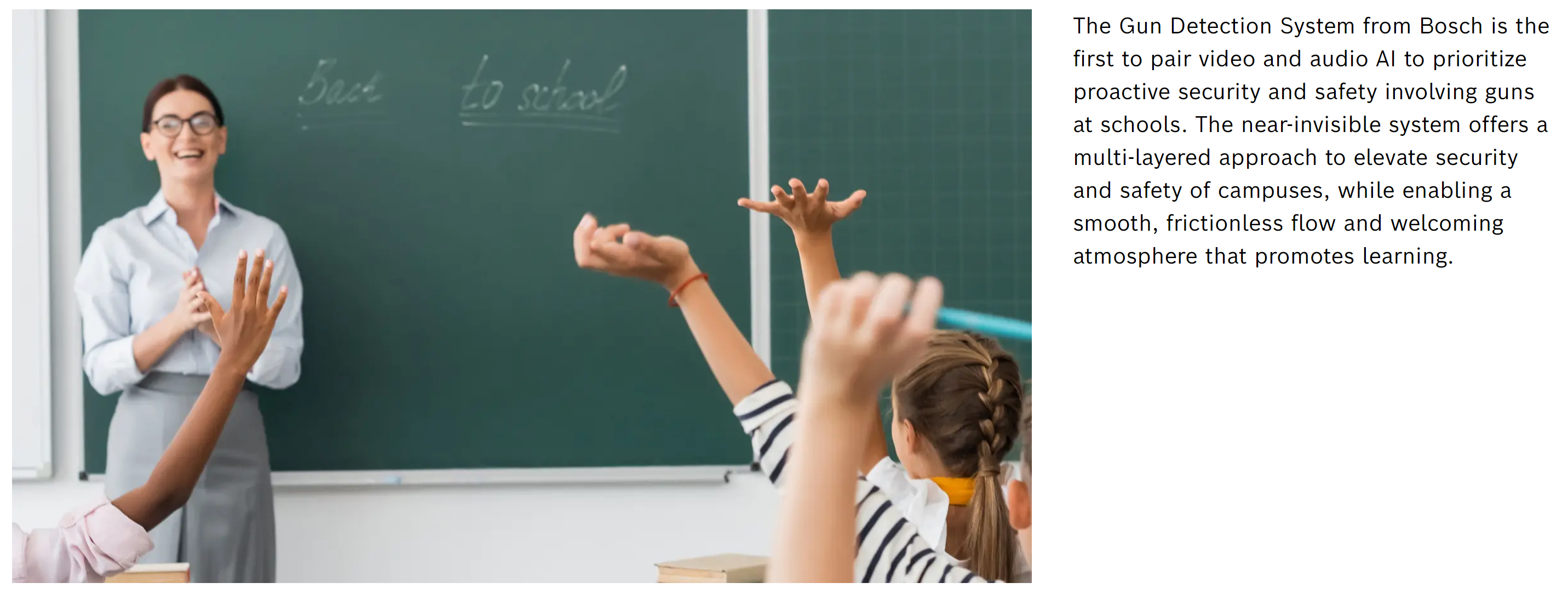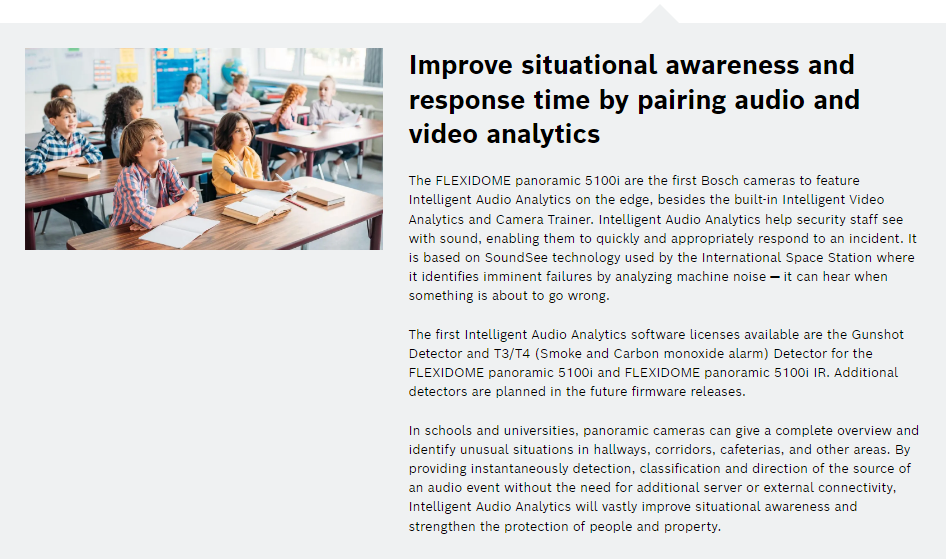Immediate detection and notification
When seconds count, let the cameras and the speakers do their job automatically. In this simple demonstration, a Bosch camera detects an unholstered gun and immediately sends a signal directly to a Bosch IP speaker to play a pre-recorded message stored in the speaker to begin the process of alerting occupants of the building.
Watch the full-length video...click here >> 
Visual gun detection and audio gunshot detection technologies play crucial roles in enhancing the safety and security of various environments, including government buildings, schools, social gathering areas, campuses, and workplaces. These technologies offer proactive and reactive measures to detect and respond to potential threats, contributing significantly to overall safety and peace of mind.
MENU: Click to Navigate This Article:
- Technology Comparison: Audio versus Visual
- Layering Both Solutions: Explanation & Demonstration
- Audio Gunshot Detection: System Details & Engineer Interview
- Visual Gun Detection: System Details & Demonstration
- Grant Funding and System Design Assistance
 Comparison of the Technologies
Comparison of the Technologies
Visual Gun Detection: Visual gun detection uses advanced video analytics and artificial intelligence to identify firearms in real-time through surveillance cameras. This technology can detect and alert security personnel to the presence of a firearm before any shots are fired, allowing for a swift response to prevent potential violence. In sensitive environments such as schools and government buildings, early detection is paramount to averting tragedies and ensuring the safety of occupants.
Importance:
- Proactive Threat Identification: Visual gun detection provides an opportunity to intercept a threat before it escalates, reducing the risk of harm.
- Deterrence: The presence of this technology can act as a deterrent, discouraging individuals from carrying firearms into secured areas.
- Immediate Response: Enables security teams to respond quickly and appropriately, potentially neutralizing a threat before it becomes a critical incident.
 Audio Gunshot Detection: Audio gunshot detection systems use acoustic sensors, like MEMS sensors, to identify and locate gunfire. These systems can distinguish gunshots from other loud noises, providing real-time alerts to security personnel and law enforcement. This technology is vital in situations where visual detection may be obscured or delayed, such as in large outdoor events or complex indoor environments.
Audio Gunshot Detection: Audio gunshot detection systems use acoustic sensors, like MEMS sensors, to identify and locate gunfire. These systems can distinguish gunshots from other loud noises, providing real-time alerts to security personnel and law enforcement. This technology is vital in situations where visual detection may be obscured or delayed, such as in large outdoor events or complex indoor environments.
Importance:
- Rapid Response: By pinpointing the exact location of gunfire, audio gunshot detection enables a faster and more coordinated response from emergency services.
- Situational Awareness: Provides valuable data on the number and location of shots fired, aiding in the effective management of the incident.
- Enhanced Safety: Helps in quickly securing the area and preventing further harm to individuals present.
Differences Between Visual and Audio Detection:
- Detection Method: Visual gun detection relies on camera systems to identify the presence of firearms, whereas audio detection uses acoustic sensors to recognize gunshots.
- Timing: Visual detection can identify a threat before shots are fired, allowing for preventative measures. Audio detection responds to the occurrence of gunfire, facilitating rapid response to an active situation.
- Coverage: Visual detection is typically limited to areas covered by cameras, whereas audio detection can cover larger areas and identify gunfire even in visually obstructed environments.
Layering Visual and Audio Gun Detection
Both technologies complement each other, providing a comprehensive safety and security solution. Visual gun detection offers the advantage of early warning, while audio gunshot detection ensures that any nearby gunfire is immediately recognized and responded to. The layered solution of visual gun detection and audio gunshot detection creates a safer environment by combining advanced technology with strategic security measures. Here's an explanation of how these systems work together to enhance safety.
Check out the excerpt from the presentation recording featuring Matt Cirnigliaro and Nils Zerrer from Bosch Security and Safety Systems where they discuss some of the latest advancements in audio and visual gun detection, focusing on what this means for users of these systems and how they can enhance safety and security in various environments.
Download Nils' and Matt's Presentation here >>
Check out the excerpt from the presentation recording featuring Dr. Florian Richter from Bosch Security and Safety Systems where he deep-dives into the latest advancements in visual gun detection, focusing on what this means for users of these systems and how they can enhance safety and security in various environments.
Download Florian's presentation here >>
Multi-Level Detection System
The demonstration in the video above simulates entry points at various types of buildings such as K-12 schools, higher education institutions, and corporate campuses. The primary goal is to showcase how a multi-level audio-visual gun detection system from Bosch can effectively identify real guns and gunshot sounds while minimizing false positives from common objects like coffee cups, cell phones, doors slamming closed, balloons popping, and other similar situations.
Key Components and Workflow
-
Initial Detection:
- Visual Detection: As individuals approach the building, the system uses visual gun detection algorithms to scan for weapons. This includes both long rifles and handguns.
- False Positive Suppression: The system is trained to distinguish between common items like cell phones or coffee cups and actual weapons. This reduces unnecessary alarms, ensuring that only genuine threats trigger alerts.
-
Threat Identification:
- Handguns: The challenge lies in differentiating handguns from similar-sized objects like cell phones. The system is fine-tuned to recognize the subtle differences and accurately identify handguns.
- Long Guns: These are generally easier to detect due to their size and shape, and they represent a significant threat in school and campus scenarios.
-
Real-Time Response:
- Notification and Action: Upon detecting a weapon, the system can send notifications through various channels, such as push notifications or integrated two-way radio systems. This enables security personnel to take immediate action, such as locking doors to prevent the gunman from entering the building.
- Visual and Audio Confirmation: If the system detects a gunshot, it combines this audio alert with visual confirmation from panoramic cameras. This dual detection ensures a higher priority alarm, prompting a swift and coordinated response.
Benefits for Safety
- Reduced False Alarms: By accurately distinguishing between common objects and weapons, the system minimizes alarm fatigue, ensuring that security personnel respond only to genuine threats.
- Real-Time Alerts: Immediate notifications allow for quick decision-making and response, enhancing the overall security posture.
- Comprehensive Coverage: The combination of visual and audio detection ensures thorough monitoring of potential threats, providing a layered safety and security approach.
- Enhanced Situational Awareness: Panoramic cameras and advanced algorithms offer a complete view of the situation, enabling security teams to act effectively.
The integration of visual gun detection and audio gunshot detection technologies provides a robust solution for creating safer environments in schools, workplaces, and other settings. By addressing the challenges of false positives and ensuring rapid response capabilities, this system significantly enhances overall security and safety.
Technical Whitepaper: Audio AI
Bosch Gun Detection System Leaflet
 Audio Gunshot Detection
Audio Gunshot Detection
Matt Golueke spoke with Bosch engineers Jacob Gallucci and Ajit Belsarkar following testing and evaluation of Bosch's audio gunshot detection system to understand at a more technical level what these engineers have been working on to perfect audio gunshot detection.
Check out the excerpt from the presentation recording featuring Matt Cirnigliaro and Nils Zerrer from Bosch Security and Safety Systems where they discuss some of the latest advancements in audio and video gun detection, focusing on what this means for users of these systems and how they can enhance safety and security in various environments.
Download Nils and Matt's Presentation here >>
The original technology of Bosch's audio gunshot detection came from the SoundSee audio AI technology. There are three main portions of this technology:
- The MEMS sensor(s). which is in the camera
- The signal processing, which is in software and hardware in the camera
- The audio AI, the machine learning aspect of it in the camera
 Technology Advantage: All in the camera, all at the edge.
Technology Advantage: All in the camera, all at the edge.
The advantage is that you don't have to send any data to the cloud. Everything is done on the processor itself, within the camera. The speed from an event occurring to when you're getting an alarm is much faster. The audio is being sampled four times every second. So, from the time a gunshot occurs to the time the camera detects the gunshot and starts sending out alerts to your VMS is very fast, between 250 to 500 milliseconds. Whereas if you're using a computer in the cloud or in your server rack, running a big AI model, you're at the mercy of the latency of your network and computers to get your detection. And then from there, even more latency to get it out to whoever needs to see and confirm this detection.
The processor, which is a high end processor on this Bosch FLEXIDOME panoramic 5100i (IR) camera allows you to run AI models at very high speeds. They are tens of milliseconds, as opposed to if a competitive system is sending data to a cloud for processing.
The Bosch solution starts with the MEMS sensor in the housing, which is then connected to a audio codec, which converts the analog signal into the digital component for the system.

The system then is taking in that digital signal and it's being converted into what's called a spectrogram. It's a picture of sound, for all intents and purposes.

That picture of sound is then given to the AI model. The AI model then predicts whether this is a gunshot or not. That AI model has been trained with at least 10,000 gunshots from 20 plus different firearms, at multiple distances, along with at least 200,000 examples of false positive information.
If you take the spectrogram of each gun and you observe it, you will see that they are different. And then you can also see the spectrograms of other audio events, say, for example, if you're playing sound of a gunshot through a speaker.
Bosch started playing audio recordings of gunshots through a speaker and that was helpful in the very beginning stages, but eventually the audio AI got so good that it just wasn't working when using a speaker anymore. As Bosch engineers started going to gun ranges and testing with different types of guns, and started incorporating that data into their system, you could already see that the speaker-based gunshot sound was no longer working, which is what was desired. The speaker can't produce the sharp impulse sound that a gunshot can, or a car backfiring. It can't produce a dense signal of all the frequencies because of how the speaker moves, or oscillates. When you look at the spectrogram, there are "gaps" in the sound signature.
Installer Settings
Environments are unique. You have retail, you have traffic, you have theaters, indoors and outdoors. Bosch has taken thousands of gunshots and augmented that data on top of common environmental sounds. There are hours and hours of recording of traffic and crowds. Hours of hours of recording fireworks. That amount of data is one of the strengths of the Bosch system.
Testing
It is very difficult to test a gunshot system. You cannot be certain 100 percent unless you shoot a gun and see the system react in your unique environment. However, Bosch has done is a couple of things to help:
- One is to make sure that the default experience that installer gets without much intervention is the best setting, which is where Bosch has selected the thresholds and the gain levels that are best suited for most environments. However, if you are an advanced customer, you know your environment, you have additional settings and can change them.
- Second is if you just want to test the operation of the system you have the fire alarm test in it. You can do a carbon monoxide or fire alarm test and see that the entire system is operating properly. The sound of a fire alarm is "T3 and T4 alarms." They're the standardized sound for a smoke alarm and a carbon monoxide alarm, respectively. A maintenance technician can push the test button on a smoke detector, it makes its sound, and you can verify the camera can hear it and detects it properly.
- There is also a demo mode. Bosch has loaded audio clips of different types of guns into the camera itself. And when you play those sounds, you're actually running the same AI model that you would run as if you were doing actual gunshot testing.
It's very difficult to do a live gunfire test, so you can at least use these methods to build your confidence that that system is actually doing what it's supposed to do.
Bosch incorporated testing blanks as well, however, the main focus has been the actual gunshot sounds. So, the fact remains, if you want to truly test any audio gunshot detection system you need to make arrangements and have a live fire exercise to ensure proper functionality. Any other way you test it that isn't a live gunshot, is a false positive detection. The system is meant to detect gunshots, and that's ideally the only thing it detects.
On the other hand, you can do false positive testing. You can pop a balloon, you can do car misfire, you can do all other kinds of audio events, like a firecracker or something similar, where you can see if your system would create a false positive alarm.
Audio Privacy
If you want to or are required to turn audio recording off, yet you want the gunshot detection to be running in the camera, this is possible. The audio used by the gunshot detection system is completely separate from the audio that can be used to capture voices for surveillance or similar operations. It's a dedicated audio stream just for gunshot detection and that that stream is never accessible from outside the camera, even if you have audio enabled.
The Bosch gunshot detection system does the signal processing and after that, that clip is thrown away. So there's no recording going into any storage.
How AI is enabling the audio and visual gun detection systems?
Check out this presentation from Dr. Florian Richter at the 2024 Security Technology Forum where Florian deep-dives into not only gun detection, but also calibration and object attributes. The gun detection-specific section starts at 24:50, but you should really watch the entire session to better understand the value of AI to these systems.
Download Florian's presentation here >>
Technical Whitepaper: Audio AI
Bosch Gun Detection System Leaflet
Series Options
Visual Gun Detection
We conducted a field evaluation of Bosch's innovative visual gun detection system, demonstrating its capabilities and effectiveness in outdoor and indoor scenarios. The video below captures our evaluation process and results.
Visual Gun Detection System Overview
 Simple three-camera setup:
Simple three-camera setup:
Detection Cameras Configuration:
- Positioned on either side of funnel point to provide multiple perspectives.
- Ensures broadside views of guns, which are often hard to detect head-on.
- Cameras are zoomed in on a small area or funnel point for precise detection.
Panoramic Camera:
- Offers situational awareness beyond the visual gun detection zone.
- Includes audio gunshot detection to alert about potential threats even outside the detection cameras' visual range.
Detection Capabilities
Long Gun Detection:

- This is the primary threat in many active shooter scenarios.
- The system detects the threat as it approaches the funnel point.
Handgun Detection:

- Handguns are smaller and harder to detect.
- The system successfully identifies the threat even with limited pixels on target.
False Positive Suppression:


- Common items like coffee cups and cell phones, often mistaken for weapons by other systems, are not flagged by Bosch’s system.
- This reduces unnecessary alarms, especially in environments like K-12 schools, campuses, and office buildings where such items are prevalent.
 Operator's Perspective
Operator's Perspective
- Visual Feed: Multiple angles provided by the gun detection cameras.
- Panoramic View: Ensures total situational awareness, complementing the focused views of the gun detection cameras.
Layered Indoor and Outdoor Detection
- The system identifies threats both outside and inside the building.
- Supplementary to metal detectors and other systems, enhancing overall security.
Frictionless Detection with Scalable Alerting Options
- Non-threatening individuals can pass through without triggering alarms.
- Bosch’s system can operate independently or integrate with various Video Management Systems (VMS), offering flexible deployment options.
Bosch’s Visual Gun Detection System stands out as a robust and effective solution for enhancing security across diverse settings. Its precise threat detection capabilities, combined with the ability to minimize false positives, make it an invaluable tool for safeguarding public spaces. The comprehensive field evaluation clearly demonstrates its potential to significantly improve security measures, ensuring a safer environment for all.

With too many instances of violence in our schools and public spaces, prevention is critical for educators and officials who must keep students, faculty, and staff safe. When students feel safe at school, they can focus on learning, resulting in improved academic performance.

In the video below from a recent Security Technology Forum, Nils Zerrer, Florian Richter, and Matt Cirnigliaro demonstrate and explain Bosch's new layered solution approach to safety featuring audio gunshot detection and visual gun detection.
Key chapters:
- 0:00 - Introduction
- 0:30 - Building Entry Point Overview
- 4:12 - Gun and Gunshot Detection Solutions Introduction
- 6:19 - Layered Technology Approach: AI-enabled Audio and Video Technology
- 9:27 - AI-enabled IVA Pro Visual Gun Detection System
- 20:44 - Gun Detection System Demonstration
- 21:50 - Instant Replay Verification Layer Demonstration
- 27:10 - Q&A
Reliable detection for peace of mind
The Gun Detection System from Bosch is the first to pair video and audio AI to prioritize proactive security and safety involving guns at schools. The near-invisible system offers a multi-layered approach to elevate the security and safety of campuses while enabling a smooth, frictionless flow and welcoming atmosphere that promotes learning.
When someone brandishing a gun enters the school, the system is designed to promptly alert personnel who can verify the gun and take proactive measures. If a gun is not visually detected, audio AI, the second layer, is designed to detect and classify gunshots precisely while accurately estimating the direction from which the sound originates. This capability may enable quick and appropriate responses. And since the system’s visual and audio layers are camera-based, security staff can always rely on high-quality video footage for forensics supporting first responders.
The Power of a Layered Approach
Bosch's Gun Detection System can operate independently, but it is also compatible with other systems like Bosch's Audio Gunshot Detection System, video surveillance, access control, and public address. These integration paths enable additional responses like human verification, locking doors, initiating automated public address and two-way radio announcements, and dictating smart lockdown and evacuation protocols.
Install the system at entrances, high traffic funnel points, and approach paths up to 30-feet wide to provide early warning while remaining nearly transparent and frictionless as opposed to metal detection systems. This system consists of the following components:
Elementary and Secondary School Emergency Relief Fund (ESSER) and grant writing support
Interested in upgrading your school security, but need funding? Bosch is partnering with a grant writing agency to help you understand federal funding eligibility, ESSER funding details, and grant opportunities.
Bosch Gun Detection System Leaflet
Technical Whitepaper: Audio AI
Get a Demonstration and System Design Assistance
Our team is your local resource for system design, demonstration, and pricing. Contact us to discuss your safety and security challenges >>














